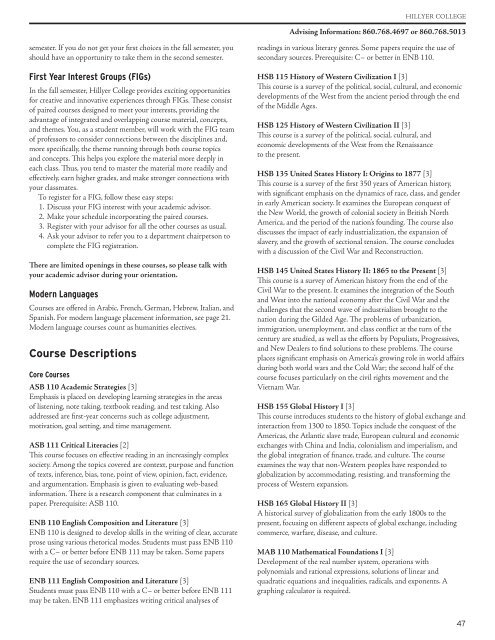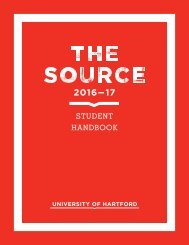advising
Create successful ePaper yourself
Turn your PDF publications into a flip-book with our unique Google optimized e-Paper software.
HILLYER COLLEGE<br />
Advising Information: 860.768.4697 or 860.768.5013<br />
semester. If you do not get your first choices in the fall semester, you<br />
should have an opportunity to take them in the second semester.<br />
First Year Interest Groups (FIGs)<br />
In the fall semester, Hillyer College provides exciting opportunities<br />
for creative and innovative experiences through FIGs. These consist<br />
of paired courses designed to meet your interests, providing the<br />
advantage of integrated and overlapping course material, concepts,<br />
and themes. You, as a student member, will work with the FIG team<br />
of professors to consider connections between the disciplines and,<br />
more specifically, the theme running through both course topics<br />
and concepts. This helps you explore the material more deeply in<br />
each class. Thus, you tend to master the material more readily and<br />
effectively, earn higher grades, and make stronger connections with<br />
your classmates.<br />
To register for a FIG, follow these easy steps:<br />
1. Discuss your FIG interest with your academic advisor.<br />
2. Make your schedule incorporating the paired courses.<br />
3. Register with your advisor for all the other courses as usual.<br />
4. Ask your advisor to refer you to a department chairperson to<br />
complete the FIG registration.<br />
There are limited openings in these courses, so please talk with<br />
your academic advisor during your orientation.<br />
Modern Languages<br />
Courses are offered in Arabic, French, German, Hebrew, Italian, and<br />
Spanish. For modern language placement information, see page 21.<br />
Modern language courses count as humanities electives.<br />
Course Descriptions<br />
Core Courses<br />
ASB 110 Academic Strategies [3]<br />
Emphasis is placed on developing learning strategies in the areas<br />
of listening, note taking, textbook reading, and test taking. Also<br />
addressed are first-year concerns such as college adjustment,<br />
motivation, goal setting, and time management.<br />
ASB 111 Critical Literacies [2]<br />
This course focuses on effective reading in an increasingly complex<br />
society. Among the topics covered are context, purpose and function<br />
of texts, inference, bias, tone, point of view, opinion, fact, evidence,<br />
and argumentation. Emphasis is given to evaluating web-based<br />
information. There is a research component that culminates in a<br />
paper. Prerequisite: ASB 110.<br />
ENB 110 English Composition and Literature [3]<br />
ENB 110 is designed to develop skills in the writing of clear, accurate<br />
prose using various rhetorical modes. Students must pass ENB 110<br />
with a C– or better before ENB 111 may be taken. Some papers<br />
require the use of secondary sources.<br />
ENB 111 English Composition and Literature [3]<br />
Students must pass ENB 110 with a C– or better before ENB 111<br />
may be taken. ENB 111 emphasizes writing critical analyses of<br />
readings in various literary genres. Some papers require the use of<br />
secondary sources. Prerequisite: C– or better in ENB 110.<br />
HSB 115 History of Western Civilization I [3]<br />
This course is a survey of the political, social, cultural, and economic<br />
developments of the West from the ancient period through the end<br />
of the Middle Ages.<br />
HSB 125 History of Western Civilization II [3]<br />
This course is a survey of the political, social, cultural, and<br />
economic developments of the West from the Renaissance<br />
to the present.<br />
HSB 135 United States History I: Origins to 1877 [3]<br />
This course is a survey of the first 350 years of American history,<br />
with significant emphasis on the dynamics of race, class, and gender<br />
in early American society. It examines the European conquest of<br />
the New World, the growth of colonial society in British North<br />
America, and the period of the nation’s founding. The course also<br />
discusses the impact of early industrialization, the expansion of<br />
slavery, and the growth of sectional tension. The course concludes<br />
with a discussion of the Civil War and Reconstruction.<br />
HSB 145 United States History II: 1865 to the Present [3]<br />
This course is a survey of American history from the end of the<br />
Civil War to the present. It examines the integration of the South<br />
and West into the national economy after the Civil War and the<br />
challenges that the second wave of industrialism brought to the<br />
nation during the Gilded Age. The problems of urbanization,<br />
immigration, unemployment, and class conflict at the turn of the<br />
century are studied, as well as the efforts by Populists, Progressives,<br />
and New Dealers to find solutions to these problems. The course<br />
places significant emphasis on America’s growing role in world affairs<br />
during both world wars and the Cold War; the second half of the<br />
course focuses particularly on the civil rights movement and the<br />
Vietnam War.<br />
HSB 155 Global History I [3]<br />
This course introduces students to the history of global exchange and<br />
interaction from 1300 to 1850. Topics include the conquest of the<br />
Americas, the Atlantic slave trade, European cultural and economic<br />
exchanges with China and India, colonialism and imperialism, and<br />
the global integration of finance, trade, and culture. The course<br />
examines the way that non-Western peoples have responded to<br />
globalization by accommodating, resisting, and transforming the<br />
process of Western expansion.<br />
HSB 165 Global History II [3]<br />
A historical survey of globalization from the early 1800s to the<br />
present, focusing on different aspects of global exchange, including<br />
commerce, warfare, disease, and culture.<br />
MAB 110 Mathematical Foundations I [3]<br />
Development of the real number system, operations with<br />
polynomials and rational expressions, solutions of linear and<br />
quadratic equations and inequalities, radicals, and exponents. A<br />
graphing calculator is required.<br />
47



